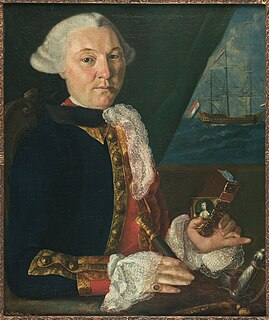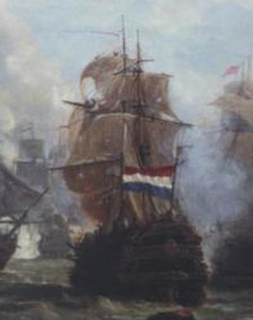
The Batavian Republic was the successor state to the Republic of the Seven United Netherlands. It was proclaimed on 19 January 1795 and ended on 5 June 1806, with the accession of Louis Bonaparte to the Dutch throne. From October 1801 onward, it was known as the Batavian Commonwealth. Both names refer to the Germanic tribe of the Batavi, representing both the Dutch ancestry and their ancient quest for liberty in their nationalistic lore.

In the Low Countries, stadtholder was an office of steward, designated a medieval official and then a national leader. The stadtholder was the replacement of the duke or count of a province during the Burgundian and Habsburg period.
West Friesland or Westfriesland can refer to the following:
Admiralty most often refers to:
Two Dutch ships of one or other of the five regional Admiralties within the United Provinces of the Netherlands have borne the name Brederode, named after Johan Wolfert van Brederode, the brother-in-law of stadtholder Frederick Henry, Prince of Orange :

The Admiralty of Amsterdam was the largest of the five Dutch admiralties at the time of the Dutch Republic. The administration of the various admiralties was strongly influenced by provincial interests. The territory for which Amsterdam was responsible was limited to the city itself, the Gooi region, the islands of Texel, Vlieland and Terschelling, the province of Utrecht and the Gelderland quarters of Arnhem and of the Graafschap (county) of Zutphen. Amsterdam had developed into the most important of all the admiralties and often compensated for the other admiralties' deficiencies. When the "Committee for Naval Affairs" replaced the Admiralty Colleges on 27 February 1795 during the reforms by the Batavian Republic, the lower civil servants were kept on, but the officers were dismissed.

Mr. Joan Cornelis van der Hoop was a Dutch lawyer, public prosecutor and minister and, at the time of the Dutch Republic, fulfilled important positions under king William I and - with the exception of the Batavian-French era - left his mark on the Dutch navy. A street is named after him in Amsterdam.
The Admiralty of Rotterdam, also called the Admiralty of de Maze, was one of the five Dutch admiralties in the Dutch Republic.

The Admiralty of Friesland or Frisian Admiralty was one of the five Dutch admiralties of the Dutch Republic. Set up on 6 March 1596, it was dissolved in 1795 during the reforms by the Batavian Republic.

The Admiralty of the Noorderkwartier, also known as the Admiralty of West Friesland, was one of the five admiralties of the Dutch Republic, made up of West Friesland, a region in the north of the province of Holland.
The Admiralty of Zeeland was one of the five admiralties of the navy of the Dutch Republic. One of its famous admirals was Joost Banckert. The Admiralty of Zeeland was disestablished in 1795, alongside the other admiralties.
Five vessels of the Royal Navy have borne the name HMS Prince Edward:
Five ships and a shore establishment of the Royal Navy have borne the name HMS Malabar, after Malabar, a region of India:

Jacobus Deketh was a captain in the Frisian Admiralty, one of the five admiralties of the Dutch Republic. In 1744 at the age of 18, Deketh joined the Admiralty of Amsterdam. He became a lieutenant and later extraordinary captain and sailed to the Dutch East Indies. In 1758, Deketh continued his career in the Frisian Admiralty. He became captain of a ship, Edam. He was appointed full captain of the Frisian Admiralty in 1760.

The action of 22 August 1795 was a minor naval engagement during the French Revolutionary Wars between a squadron of four British Royal Navy frigates and two frigates and a cutter from the Batavian Navy. The engagement was fought off the Norwegian coastal island of Eigerøya, then in Danish Norway, the opposing forces engaged in protecting their respective countries' trade routes to the Baltic Sea. War between Britain and the Batavian Republic began, undeclared, in the spring of 1795 after the Admiralty ordered British warships to intercept Batavian shipping following the conquest of the Dutch Republic by the French Republic in January 1795.
Four ships of the Royal Navy have borne the name HMS Pandour, after the Pandurs, an 18th-century force of Croatian soldiers, who served the Habsburg monarchy as skirmishers and who had a reputation for brutality:

The Rijkswerf in Amsterdam was a Dutch shipyard that build a significant amount of warships for the Royal Netherlands Navy.

Six Dutch ships of one or other of the five regional Admiralties within the United Provinces of the Netherlands have borne the name Beschermer or Schermer:

The Admiraal Tjerk Hiddes de Vries was a Dutch 68-gun third rate ship of the line of the navy of the Admiralty of Friesland, one of five provincial naval forces of the United Republic of the Netherlands' In 1795, following the French occupation of the Netherlands, this ship was taken over by the Batavian Republic, and in 1797 was captured by the Royal Navy. The order to construct the ship was given by the Admiralty of Friesland. In 1783 the Admiraal Tjerk Hiddes de Vries sailed to the Mediterranean Sea under Captain Van der Beets. When she returned in the Dutch Republic she was laid up in ordinary until 1795.

Four Dutch ships of the Admiralty of Amsterdam have borne the name Batavier or Batavia, named after the ancient Germanic tribe of the Batavi, who inhabited the region of Batavia around Nijmegen:
This page is based on this
Wikipedia article Text is available under the
CC BY-SA 4.0 license; additional terms may apply.
Images, videos and audio are available under their respective licenses.











